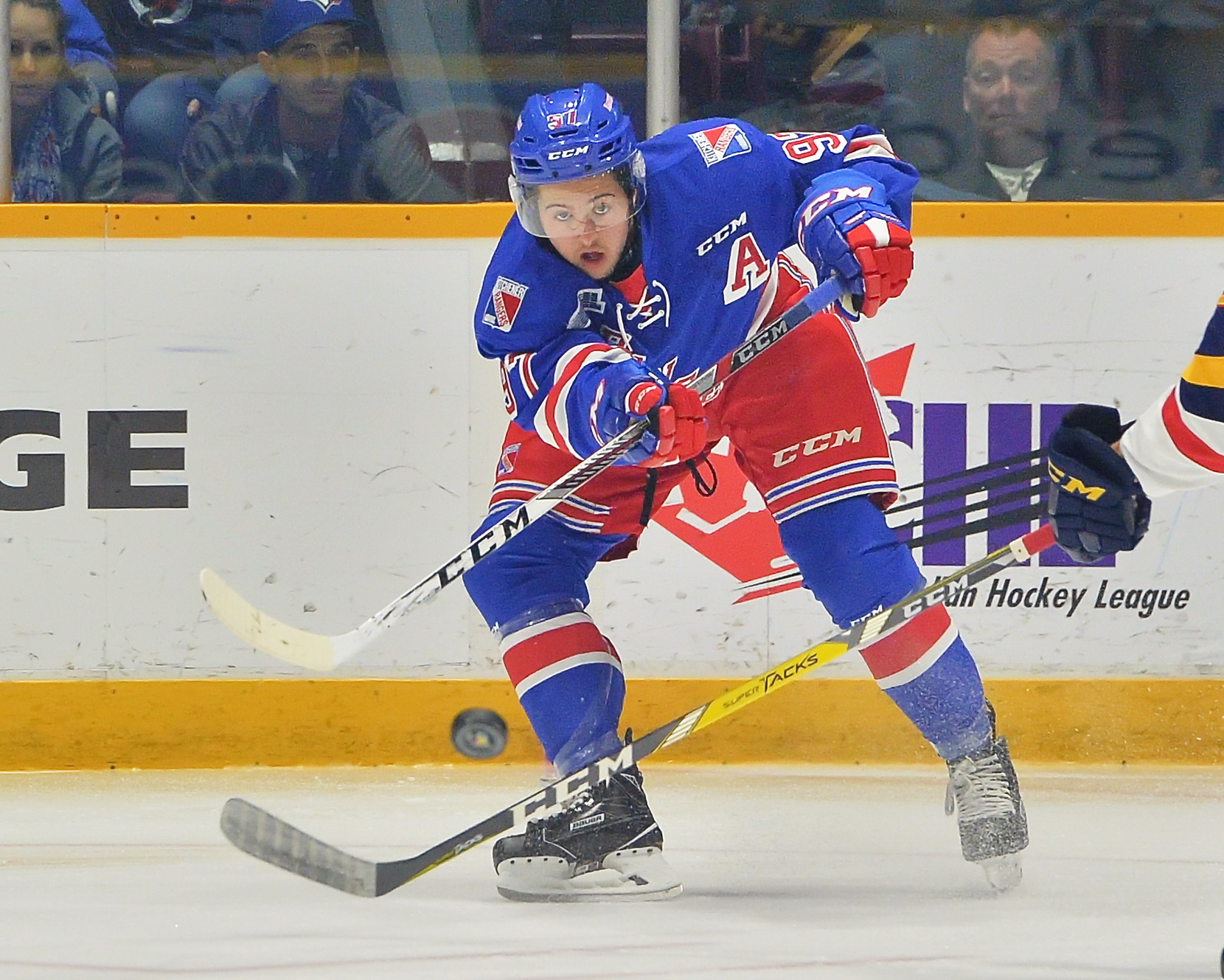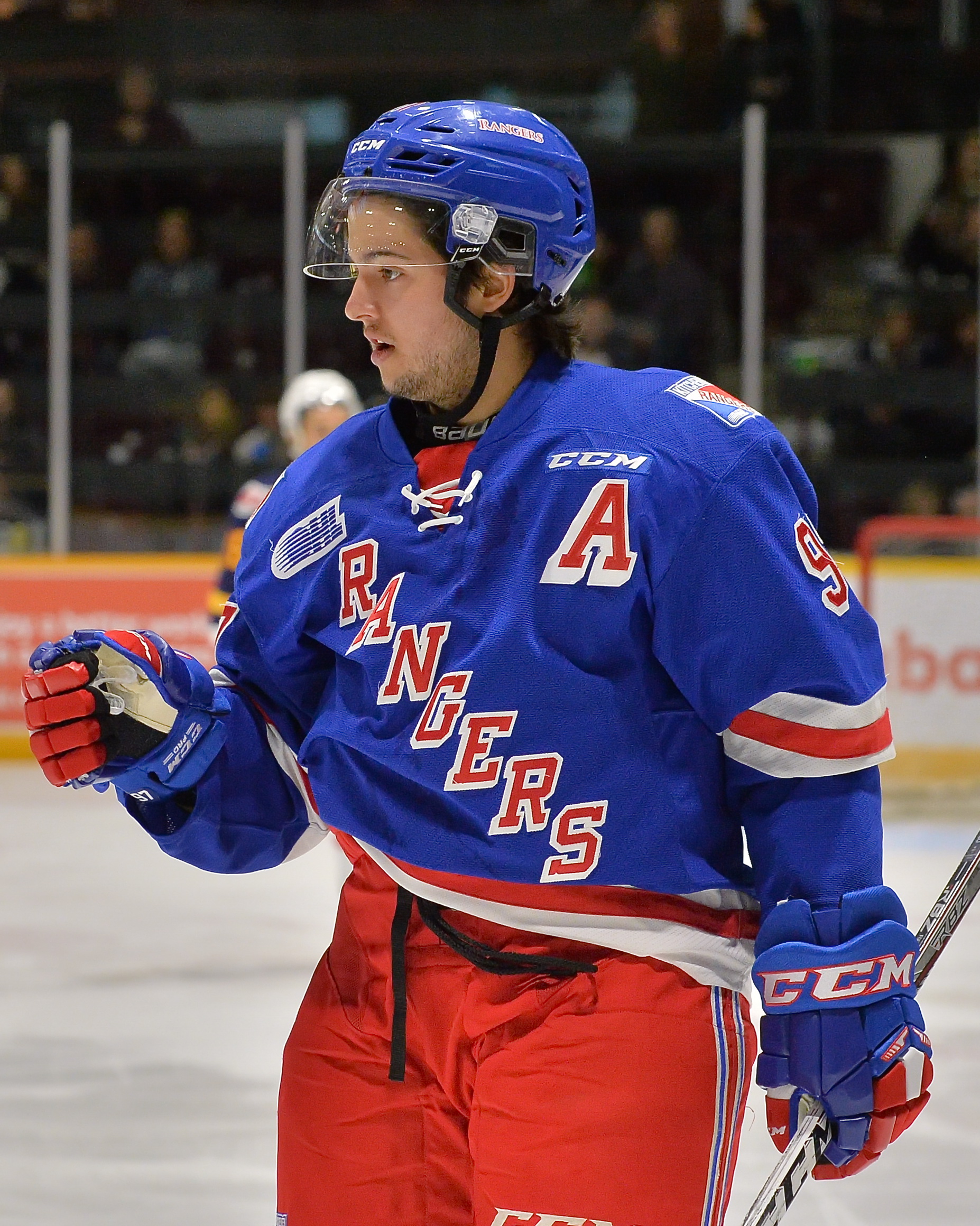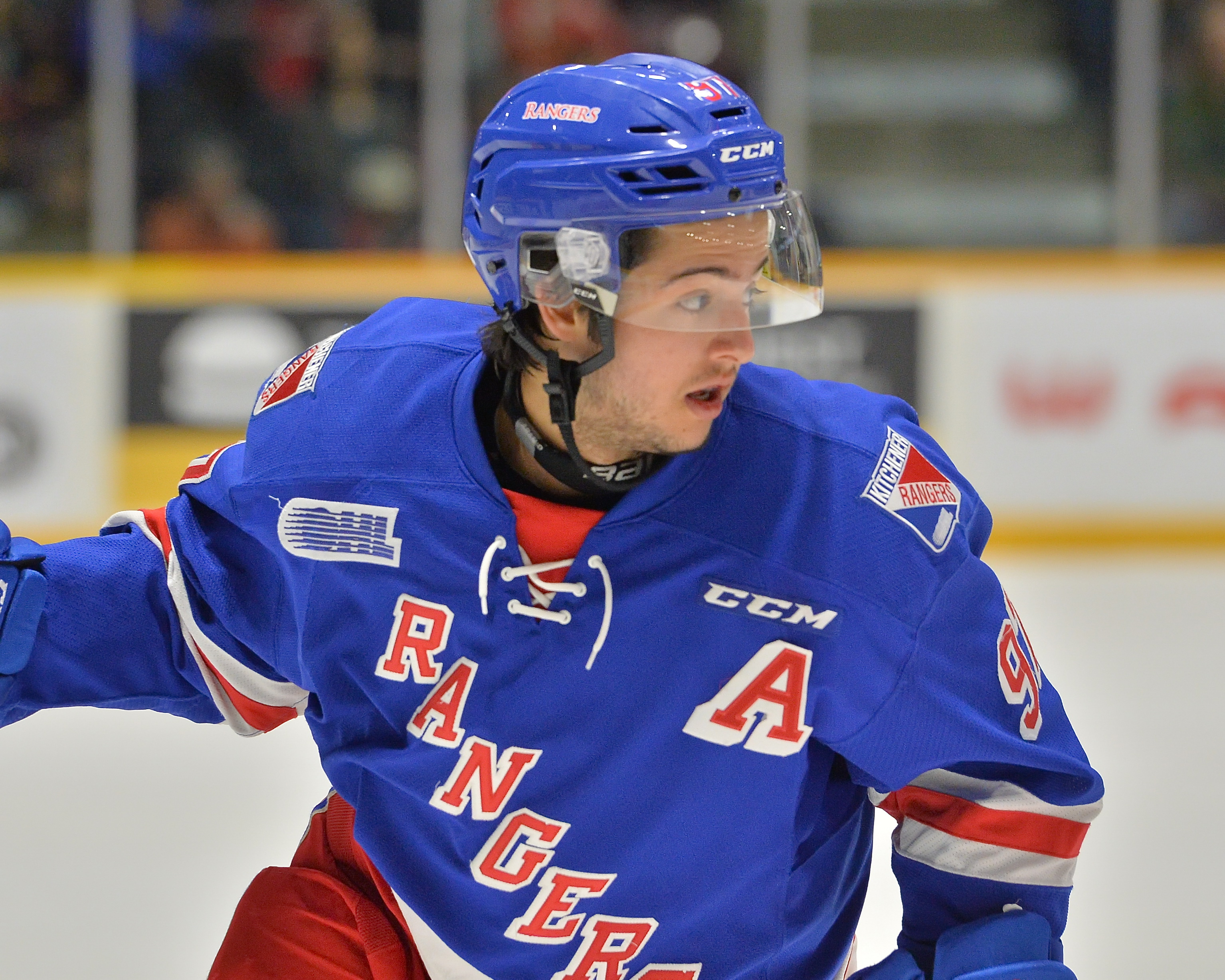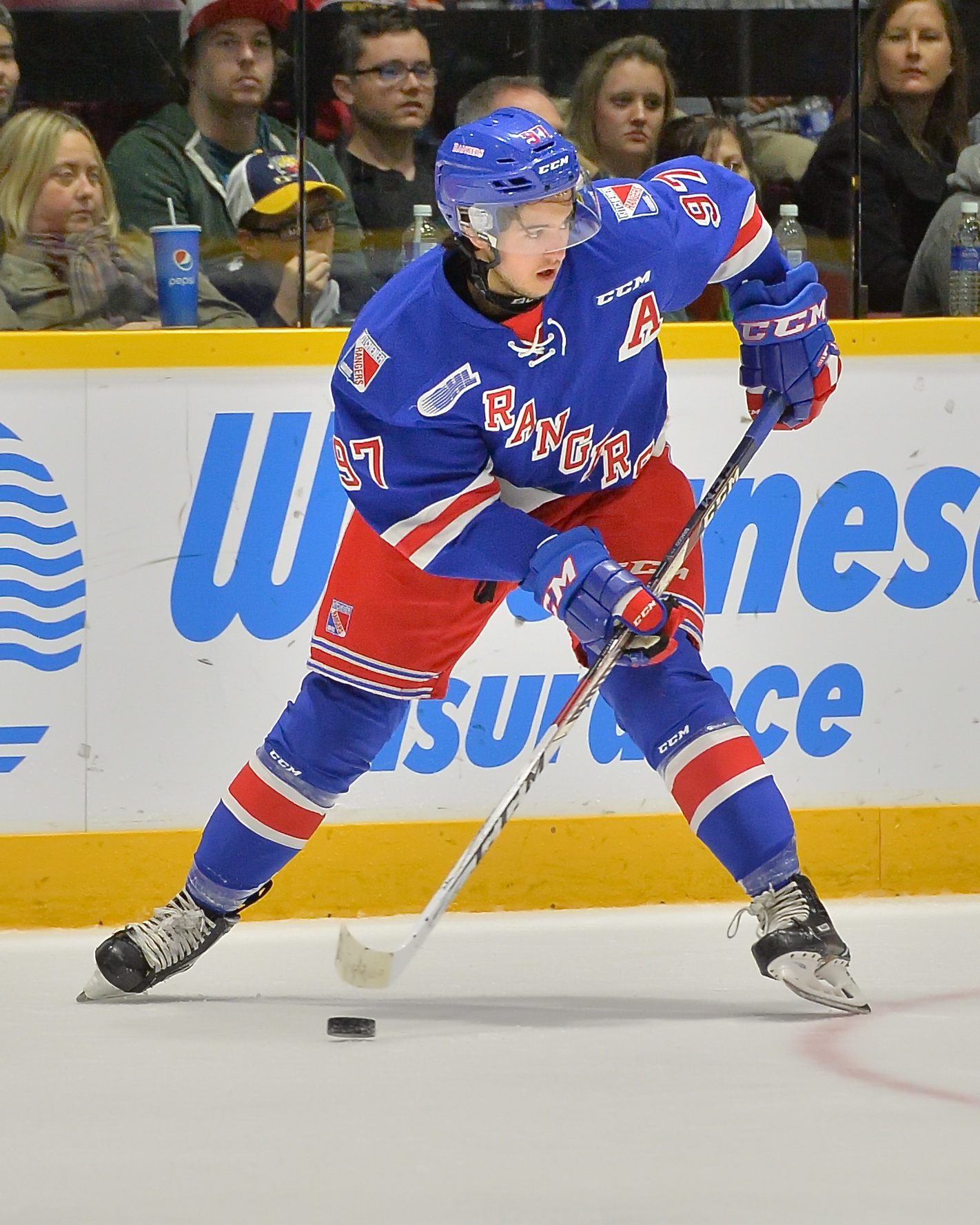With another three-point game versus the Sarnia Sting on November 23rd, Toronto Maple Leafs prospect Jeremy Bracco moved up to second place in the OHL scoring race with 43 points in 20 games.
Since returning from Leafs training camp, the former second round draft selection in 2015 hasn’t gone without a point in the first 20 games of his second OHL season with the Kitchener Rangers. He’s scored two or more points in half of those games, including six three-point nights, two four-point nights, and a five-point game versus Guelph on October 16.
I caught up with Rangers head coach Jay McKee this week to gain some insights on Bracco’s big start to the season and the overall progression of his game.
Alec Brownscombe: A general, open-ended question to start: You saw Jeremy Bracco enter the OHL after leaving college at the start of last season. What kind of growth have you seen in his game over the course of the past calendar year, from his rookie season to his fantastic start to 2016-17?
Jay McKee: I just think his confidence level is raised. He’s an elite playmaker, there’s no question. I think, over the summer, his skating has gotten even better. He has a very elusive stride. He goes to the “10 and 2” stride, but he does that going forward on the rush. I think that throws defencemen off. He’s the only player I’ve ever seen, actually, that can pick up speed doing it. He’s able to drive by defencemen wide, and his vision is elite. He’s playing with a tonne of confidence this year. He’s having a lot of fun on the ice. He’s been real solid for us.
Brownscombe: I was going to mention that “10 and 2” stride, actually. The way Bracco opens his hips and uses the edges of his skates to go heel to heel reminds me of a former Kitchener Ranger in Jeff Skinner. Skinner had a more explosive top gear, but I’ve noticed that’s something Jeremy uses a lot when he’s coming out from behind the net or surveying the ice, or as you say he’ll even use it on the rush quite often. Skinner honed that skill through figure skating growing up. Do you know if Bracco did the same?
McKee: I’m not sure. I’ve actually never asked him about that, if he did [figure skating] when he was younger. A guy like Doug Weight, who I played with, had the “10 and 2,” but he would typically do it when he was going east to west in the offensive zone – not on the rush. I’ve seen guys do the “10 and 2” to open up their hips and it allows them to see a lot more of the ice as opposed to just skating forward with the puck. Jeremy does it on the rush moving north with the puck, and somehow he seems to pick up speed while doing it. That’s the uniqueness of his stride. It’s just so built into his game. There are times when there is no one around him, and he’s on a rush, and he still does it. It’s just kind of ingrained in his game. It’s not so much deceiving as it is part of the way he skates. I know, as a defenceman when you see a guy do that – especially on the rush – you don’t expect him to pick up speed. Somehow, he’s incorporated a stride that you don’t see very often. He definitely picks up speed when he does it.

Brownscombe: Do you ever find he relies on it too often on the rush or is that something he knows how to use at the right times in order to get a defenceman to maybe bite, opening up a pass?
McKee: It’s not overused. It is just part of the way he skates. I don’t even know if he’s necessarily trying to be deceiving sometimes. I think it is just part of how he skates. It’s just naturally deceiving because defencemen don’t see it often – very rarely do you see it, if ever, on a rush. I know, if I was a defenceman defending it, I wouldn’t be expecting a guy to pick up speed. It looks like he is opening up in order to open up some passing lanes or to see more of the ice, but he definitely picks up speed on it.
Brownscombe: Jeremy is already up to 16 goals in 20 games, just four shy of his 20 in 49 last season. He’s shooting on sight – he’s got a bunch of six, seven, and even eight shot games. You’ve praised his vision and playmaking abilities as among the best in the OHL, and he’s been described as a pass-first kid in the past. Are you seeing him develop more of a shooter’s mentality so far this season?
McKee: Everyone who he plays against knows he is an elite passer. I think he’s typically been a pass-first kind of guy. When you get that reputation, players start to take lanes a little bit more, and maybe give you a little bit more of a lane to the net. His shot is great. He’s got a real good shot. It’s accurate and it’s hard. He has no fear of taking over any open ice he’s given. He’s going to take it, and he has no fear of pulling the trigger. I think he’s probably realized more this year than in the past how dangerous his shot can be. He’s morphing into a bit of a double threat. He’s not just a pass-only guy. He’s definitely got a really good release and an accurate shot as well.
Brownscombe: Jeremy was eligible for the AHL this season, being drafted out of college, but he is still just 19. With a Toronto Marlies team that is stocked with young talent, the Leafs opted to give him another year of junior. It seems like he had no problem putting the disappointing news about being cut behind him and getting right down to business to start the year.
McKee: Definitely. He came in the room with a real positive attitude. Especially on the road, quite often he’s getting other teams’ top defence pairings. When you put in 20-plus minutes a night and you’re up against, quite often, other team’s top defence pairings, he’s still getting the work he needs in the way of development. There is no question that it’s a good spot for him to be right now as opposed to seeing third or fourth line minutes with a pretty deep Marlies team, seeing anywhere from nine to twelve minutes a night. It’s probably real good for him right now in terms of his development and confidence and the ability to work on his creativity, to be at this level right now. He’s taken it in stride and been very positive.

Brownscombe: Over the past few games, looking at the lines reported by Josh Brown at The Record, he’s been playing with 16-year-old rookie center Riley Damiani at even strength.
McKee: For a lot of the season he was matched up with Adam Mascherin, who I think is fourth now in league scoring. Those two were together for a lot of the season. In the past five or so games now, we put Riley Damiani at center and split Bracco and Mascherin up. I think, in the first three games since being split, they combined for 16 points. They are finding ways without each other, which is great because that allows us to add depth scoring and spread out the scoring a little bit.
Brownscombe: Has Bracco helped Damiani with his transition to the OHL? Bracco had a really similar build to Damiani when he was 16.
McKee: I think he’s been great. For Riley being 16 and having an opportunity to play with a guy who is challenging for the overall scoring title in this league I think is a confidence booster for Riley. With Jeremy, if you go to the right areas – Riley has a high hockey IQ – he is going to find you. They connected last night. It was Riley’s first goal in, I believe, 14 games. Apart from that goal, in the past few games that line, with Connor Bunnaman on it flanking the left side, has had an endless amount of chances. The goals will be coming for Riley and he’s a kid that works hard, so it’s a good complement to have out there with Jeremy.

Brownscombe: Have you seen signs of Bracco taking on a bit more of a leadership role this year with a year under his belt in the OHL?
McKee: We’re lucky in Kitchener. We have a lot of guys that could be leaders. The guys who are wearing letters right now are three overagers, but we’ve got a real good room. It’s a tight-knit room. On the ice, there’s no question he leads by his offensive abilities. We’ve had him carry us on his back for some games.
Brownscombe: The size element always comes up with Bracco… but he’s now listed at 190, which is a pretty good weight for his height. Rather than obsess over inches and pounds, though — as is the tendency in hockey sometimes — I want to get your take on his hockey strength, which is far more important than height/weight. Leafs fans and media are seeing the evidence of that now with Mitch Marner.
McKee: For sure. Typically scouts and NHL GMs look for the big, strong-skating forwards. If you are smaller in stature, you need to be an elite playmaker, and that’s what he has. He’s got that going for him. As you say, a guy like Mitch Marner, or Johnny Gaudreau. There are guys in the past that I’ve played against. Even Patrick Kane – a guy who is smaller in stature and not an overly big guy. If they have elite playmaking skills, there is always room for a guy like that on NHL rosters.

Brownscombe: Throughout your NHL career, you have played with some sub-six-foot skilled players that had successful NHL careers. You played with and practiced against a legendary one in Paul Kariya in your stint in St. Louis. Andy MacDonald was in St. Louis with you then, too. You played for a number of years with Danny Briere and Derek Roy in Buffalo. In general terms, what were some of the traits that helped those players not only survive but thrive in the NHL, and do you see those kind of traits in Jeremy?
McKee: Those guys’ core and leg muscles have to be very strong. When you’re out there battling against guys who are 6’3, 220 pounds, you have to be strong on your feet. Those guys are all elite playmakers. If you’re smaller in stature and you’re not bringing something that’s elite, it’s going to be a tough league to crack. When you have the vision, and the passing abilities, and you’re strong on your legs and your feet, there is definitely room. You can win or lose on the powerplay with guys that have that type of vision; the guys who can get out there on the powerplay and do some damage while holding their own at five on five. Teams are definitely looking for those guys all the time.
Personally, as a former defenceman, I typically found the smaller and speedier guys – the guys that you say have, “grease on their hips,” or the ones that were slick at getting by you – harder to play against than the bigger guys that you could get a hold of. The tight turners in the corners – the Crosbys, those guys that don’t stop working – are the tougher ones to play against.
Brownscombe: Even since you retired, the league has only become friendlier to the small skilled guy. It’s faster and more skilled than ever.
McKee: It starts in our league even. They’re taking the aggression a little bit out of the game. There are not as many fights. Even with big hits, I’ve seen some big hits that wouldn’t be a penalty back when I played but are now suspensions. It’s obviously to keep injuries – head injuries, especially – cracked down on, but it’s taken out some of the aggression and even some of the scrums after whistles. It’s a different game nowadays than it was 10, 15, 25 years ago. It was more of an aggressive game with more clutching and grabbing. With that leaving the game, it’s definitely opened doors for the smaller, skilled guys.
































